Popular categories
Looking for a yarn?

100% Alpaca
from 4.65 $ /50g
The yarn cost is calculated from the pattern’s smallest size and the yarn’s cheapest product type. Looking for an even better price? You might find it on the DROPS Deals!
Winter Grace Jacket
Jacket with cables, lace pattern and raglan, knitted top down. Size: S - XXXL Piece is knitted in DROPS Puna.
DROPS design: Pattern pu-021
Yarn group B
----------------------------------------------------------
Size: S - M - L - XL - XXL - XXXL
Materials:
DROPS PUNA from Garnstudio (belongs to yarn group B)
450-500-550-600-650-700 g color 01, off white
Piece can also be knitted with yarn from:
"Alternative yarn (yarn group B)" - see link below.
DROPS DOUBLE POINTED NEEDLES AND CIRCULAR NEEDLE (40 and 60 or 80 cm / 16" + 24" or 32") SIZE 4 mm/US 6 – or size needed to get 21 stitches and 28 rows in stockinette stitch = width 10 cm / 4" and 10 cm / 4" vertically.
DROPS MOTHER-OF-PEARL BUTTON ARCHED (white), NO 521: 7-7-7-7-8-8 pieces
DROPS CABLE NEEDLE - for cables.
-------------------------------------------------------
Alternative Yarn – See how to change yarns here
Yarn Groups A to F – Use the same pattern and change the yarn here
Yarn usage using an alternative yarn – Use our yarn converter here
-------------------------------------------------------

100% Alpaca
from 4.65 $ /50g
The yarn cost is calculated from the pattern’s smallest size and the yarn’s cheapest product type. Looking for an even better price? You might find it on the DROPS Deals!
- English (US/in)
- Česky - not translated
- Dansk
- Deutsch
- Eesti keel
- English (UK/cm)
- Español
- Français
- Íslenska
- Italiano
- Magyar
- Nederlands
- Norsk
- Polski
- Português
- Suomi
- Svenska
- English (UK/cm), Bulgaria
- English (UK/cm), Croatia
- English (UK/cm), Greece
- English (UK/cm), Latvia
- English (UK/cm), Lithuania
- English (UK/cm), Romania
- English (UK/cm), Slovenia
- Česky, Slovakia - not translated
Pattern instructions
GARTER STITCH (worked in the round):
1 ridge = 2 rounds. Knit 1 round and purl 1 round.
GARTER STITCH (back and forth):
1 ridge = knit 2 rows.
PATTERN:
See diagrams A.1 to A.13. Diagrams show all rows in pattern seen from the right side. See diagram for your size in A.1, A.7, A.8 and A.12.
DECREASE TIP:
Decrease under sleeve as follows: Begin 3 stitches before marker thread, knit 2 together, knit 2 (marker thread is in the middle of these stitches), slip 1 stitch knitwise, knit 1, pass slipped stitch over stitch worked (= 2 stitches decreased).
INCREASE TIP (applies to increase in the sides of body):
Begin 1 stitch before marker, 1 yarn over, knit 2 (marker is in the middle of these 2 stitches), 1 yarn over (= 2 stitches increased). On next round work yarn overs twisted to avoid holes.
BUTTONHOLES:
Decrease first buttonhole after the 2 ridges in the neck, then decrease the next 6-6-6-6-7-7 approx. 8 cm / 3⅛" apart.
Decrease for buttonholes on right band as follows: Work until 3 stitches remain on needle (seen from right side), make 1 yarn over, knit 2 together and knit 1. On next row knit yarn over to make holes.
----------------------------------------------------------
JACKET:
Work back and forth on circular needle from mid front, work top down.
YOKE:
Cast on 97-97-105-105-113-113 stitches on circular needle size 4 mm / US 6 with Puna. Work 2 ridges in GARTER STITCH - see explanation above. On to last row in ridge increase 20-20-24-24-28-28 stitches evenly = 117-117-129-129-141-141 stitches. REMEMBER THE GAUGE! Work next row as follows from right side: 5 stitches in garter stitch (= band), A.1 (= 3-3-6-6-9-9 stitches), A.2 (= 18 stitches), 1 yarn over, 12 stitches in stockinette stitch (= sleeve), 1 yarn over, A.3 (= 18 stitches), A.4 (= 2 stitches), A.5 0-0-1-1-2-2 times (= 0-0-6-6-12-12 stitches), A.6 (= 3 stitches), A.2, 1 yarn over, 12 stitches in stockinette stitch (= sleeve), 1 yarn over, A.3, A.7 (= 3-3-6-6-9-9 stitches), 5 stitches in garter stitch (= band). Decrease for BUTTONHOLES - see explanation above.
Continue this pattern and upwards, increase as shown in A.1, A.4, A.6 and A.7. On sleeves increase on each side of the 12 stitches in stockinette stitch, increase every other row with 1 yarn over as explained above. On next row purl yarn over to make hole. Work the increased stitches in stockinette stitch. When A.1 to A.7 has been worked 1 time vertically, there are 181-181-193-193-205-205 stitches on needle. Work next row as follows from right side: 5 stitches in garter stitch, A.8 A (= 3-3-7-7-7-7 stitches) A.8 B (= 6 stitches), A.8 C (= 2-2-1-1-4-4 stitches), A.2 as before, 28 stitches in garter stitch (= sleeve), A.3 as before, A.9 (= 10 stitches), A.10 0-0-1-1-2-2 times (= 0-0-6-6-12-12 stitches), A.11 (11 = stitches), A.2 as before, 28 stitches in stockinette stitch (= sleeve), A.3 as before, A.12 A (= 2-2-1-1-4-4 stitches), A.12 B (= 6 stitches), A.12 C (= 3-3-7-7-7-7 stitches), 5 stitches in garter stitch. Continue this pattern upwards, and continue increases on sleeves. Every time A.8/A.12 is worked 1 time vertically work 2 repetitions more of A.8/A.12 B between A.8/A.12 A and A.8/A.12 C. Every time A.9, A.10 and A.11 have been worked 1 time vertically, work 4 repetitions more of A.10 between A.9 and A.11. Continue pattern until 25-29-30-35-37-43 increases have been done in total = 317-349-369-409-437-485 stitches.
Work next row as follows from wrong side: Work first 51-55-59-64-69-75 stitches (= right front piece), slip the next 62-70-72-82-86-98 stitches on a stitch holder for sleeve, cast on 8-8-10-10-12-12 new stitches under sleeve, work the next 91-99-107-117-127-139 stitches (= back piece), slip the next 62-70-72-82-86-98 stitches on a stitch holder for sleeve, cast on 8-8-10-10-12-12 new stitches, work the last 51-55-59-64-69-75 stitches on round (= left front piece). Piece measures approx. 19-21-22-26-28-31 cm / 7½"-8¼"-8¾"-10¼"-11½"-12¼" from cast-on edge. NOW MEASURE THE PIECE FROM HERE!
BODY:
= 209-225-245-265-289-313 stitches. Insert 1 marker thread in each side, in the middle of the new stitches. Continue in garter stitch, A.2 and A.3. Over stitches in A.8, A.9, A.10, A.11 and A.12 (= 55-63-71-81-91-103 stitches on back piece and 28-32-36-41-46-52 stitches on each front piece) work pattern according to A.13. Begin on the row in A.13 that makes the pattern fits on last pattern row in A.8 to A.12 - work the stitches that do not fit the pattern in the sides in stockinette stitch. REMEMBER BUTTONHOLES! When piece measures 4 cm / 1½", increase 1 stitch on each side of marker threads (= 4 stitches increased). Increase every 6 cm / 2⅜" 5 times in total = 229-245-265-285-309-333 stitches. When piece measures 36-35-37-35-36-34 cm / 14¼"-13¾"-14½"-13¾"-14¼"-13½", decrease 3 stitch over each cable in A.2 and A.3 = 217-233-253-273-297-321 stitches. Work 2 ridges over all stitches, then bind off. Jacket measures approx. 60-62-64-66-68-70 cm / 23⅝"-24⅜"-25¼"-26"-26¾"-27½" from shoulder.
SLEEVE:
Worked in the round on a short circular needle, switch to double pointed needles when needed.
Slip stitches from sleeve on a short circular needle size 4 mm / US 6, pick up 1 stitch in each of the 8-8-10-10-12-12 stitches cast on under sleeve = 70-78-82-92-98-110 stitches. Insert 1 marker thread in the middle of the new stitches under sleeve – NOW MEASURE PIECE FROM HERE. Work in stockinette stitch in the round. When piece measures 3 cm / 1", decrease 1 stitch on each side of marker - READ DECREASE TIP. Decrease every 2½-2-2-1½-1½-1 cm / ⅞"-¾"-¾"-½"-½"-¼" 14-17-18-22-24-29 times in total. After all decreases are done, 42-44-46-48-50-52 stitches remain on round. When piece measures 44-43-42-39-38-35 cm / 17¼"-17"-16½"-15¼"-15"-13¾" (shorter measurements in the larger sizes because of longer yoke), work 2 ridges in GARTER STITCH - see explanation above. Then loosely bind off by knitting. Work the other sleeve the same way.
ASSEMBLY:
Sew the buttons on to the left band.
Diagram
All measurements in charts are in cm.

|
= knit from the right side, purl from the wrong side |

|
= purl from the right side, knit from the wrong side |

|
= between 2 stitches make 1 yarn over |

|
= knit 2 together |

|
= knit 2 twisted together |

|
= slip 1 stitch knitwise, knit 1, pass slipped stitch over stitch worked |

|
= slip 1 stitch knitwise, knit 2 stitches together, pass slipped stitch over stitches worked together |

|
= slip 3 stitches on cable needle behind piece, knit 3, knit 3 from cable needle |

|
= slip 3 stitches on cable needle in front of piece, knit 3, knit 3 from cable needle |
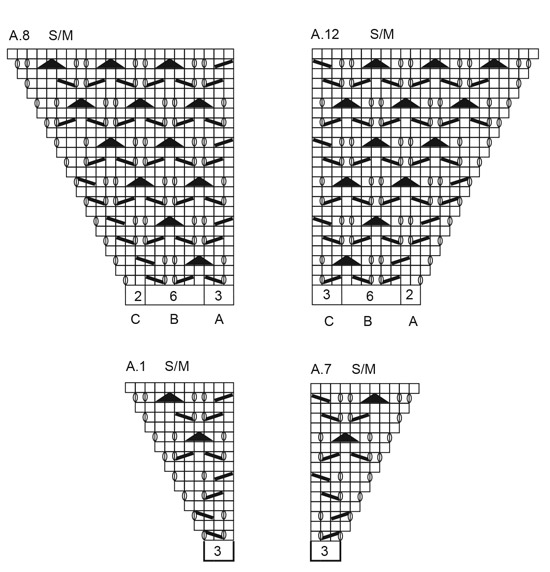
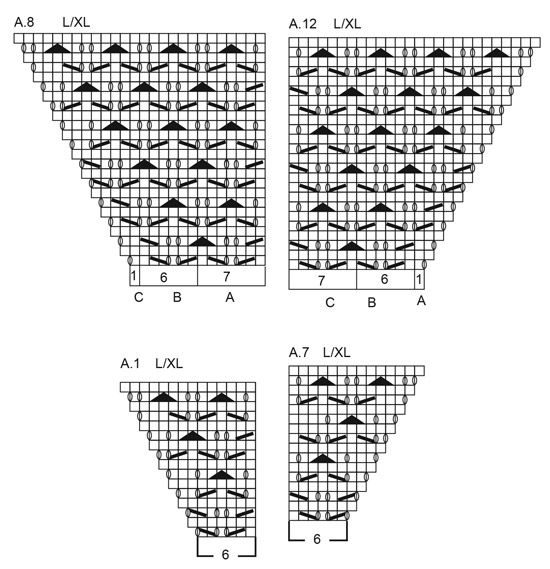
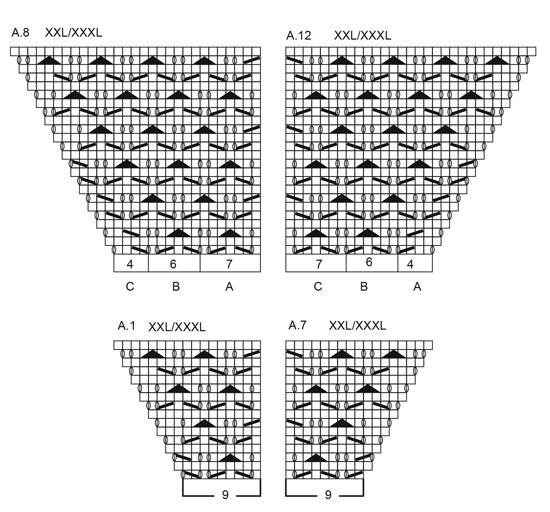
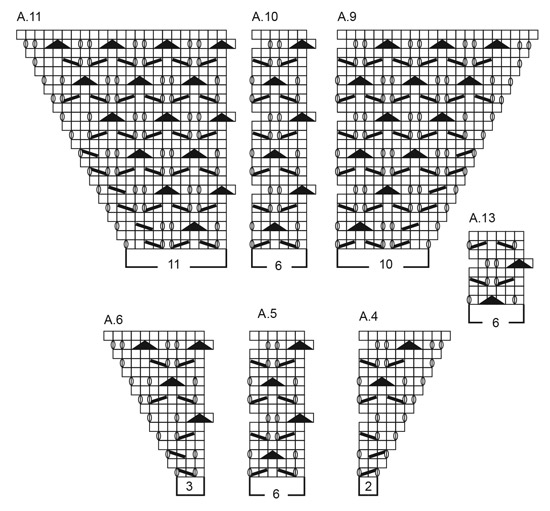
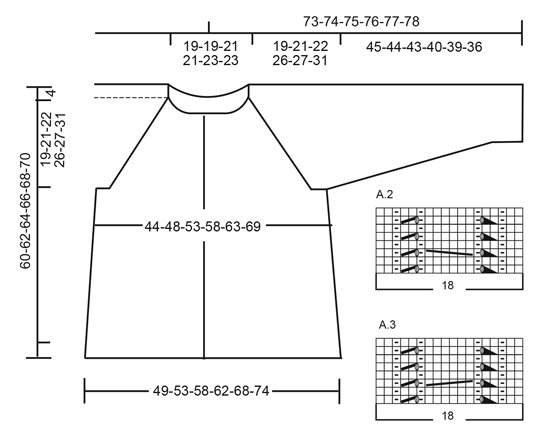
What can you do with our patterns? You can share DROPS patterns online, using the pattern original picture, materials, name and number. But you are NOT ALLOWED to reproduce the complete pattern digitally in any way. Yarn stores are welcome to use the DROPS pattern database to promote the sale of our assortment. You can print out our patterns, make as many copies as you’d like. The only thing we ask is that you don't make any changes / additions to the original printed document. And that the patterns according to the DROPS philosophy are given out to the consumers for free. Editorials that wish to publish our patterns in printed books or magazines can contact us for more information. The sale of garments based on DROPS patterns is permitted as long as they are sold as single items or per order. Further commercial use of the patterns is not permitted. It has to be clearly stated that the garment is made based on a design from DROPS DESIGN. The use of clothing labels of which DROPS DESIGN forms part is conditioned by the inclusion of the following text: “A DROPS DESIGN made by …..”. The use of DROPS photos for marketing purposes/sales is only permitted in connection with the use/sale of DROPS products. The photos may not be cut or edited and the logo should be clearly visible.
We reserve the right to withdraw the permission for use of our patterns at any time, notwithstanding the reason.
Each of our patterns has specific tutorial videos to help you.
These step-by-step tutorials might also help you:
Why is the knitting/crochet tension so important?
Knitting tension is what determines the final measurements of your work, and is usually measured per 10 x 10 cm. It is provided like so: number of stitches in width x number of rows in height - eg: 19 stitches x 26 rows = 10 x 10 cm.
The knitting tension is very individual; some people knit/crochet loosely while others work tightly. You adjust the knitting tension with the needle size, which is why the suggested needle size only serve as a guide! You need to adjust this (up or down) to ensure that YOUR knitting tension matches the knitting tension provided in the pattern. If you work with a different knitting tension than provided you will have a different yarn consumption, and your work will have different measurements than what the pattern suggests.
The knitting tension also determines which yarns can replace each other. As long as you achieve the same knitting tension you can replace one yarn with another.
See DROPS lesson: How to measure your tension/gauge
See DROPS video: How to make a gauge tension swatch
How do I know how many balls of yarn I need?
The required amount of yarn is provided in grams, eg: 450 g. To calculate how many balls you’ll need you first need to know how many grams are in 1 ball (25g, 50g or 100g). This information is available if you click on the individual yarn quality on our pages. Divide the amount required with the amount of each ball. For example, if each ball is 50g (the most common amount), the calculation will be as follows: 450 / 50 = 9 balls.
Can I use a different yarn than what the pattern suggests?
The important thing when changing from one yarn to another is that the knitting/crochet tension remains the same. This is so that the measurements of the finished piece will be the same as on the sketch provided. It is easier to achieve the same knitting tension using yarns from the same yarn group. It is also possible to work with multiple strands of a thinner yarn to achieve the knitting tension of a thicker one. Please try our yarn converter. We recommend you to always work a test swatch.
Please NOTE: when changing yarn the garment might have a different look and feel to the garment in the photo, due to individual properties and qualities of each yarn.
See DROPS lesson: Can I use a different yarn than the one mentioned in the pattern?
What are the yarn groups?
All our yarns are categorised into yarn groups (from A to F) according to thickness and knitting tension – group A contains the thinnest yarns and group F the thickest. This makes it easier for you to find alternative yarns to our patterns, should you wish to switch yarn. All yarns within the same group have a similar knitting tension and can easily replace each other. However, different yarn qualities have different structures and properties which will give the finished work a unique look and feel.
How do I use the yarn converter?
At the top of all our patterns you’ll find a link to our yarn converter, which is a helpful tool should you wish to use a different yarn than suggested. By filling in the yarn quality you wish to replace, the amount (in your size) and number of strands, the converter will present good alternative yarns with the same knitting tension. Additionally it will tell you how much you’ll require in the new qualities and whether you’ll need to work with multiple strands. Most skeins are 50g (some are 25g or 100g).
If the pattern is worked with multiple colours, every colour will have to be converted separately. Similarly, if the pattern is worked with several strands of different yarns (for example 1 strand Alpaca and 1 strand Kid-Silk) you will have to find alternatives for each, individually.
Why do you show discontinued yarns in the patterns?
Since different yarns have different qualities and textures we have chosen to keep the original yarn in our patterns. However, you can easily find options among our available qualities by using our yarn converter, or simply pick a yarn from the same yarn group.
It is possible that some retailers still have discontinued yarns in stock, or that someone has a few skeins at home that they would like to find patterns for.
The yarn converter will provide both alternative yarn as well as required amount in the new quality.
What size should I knit?
If you think it's hard to decide what size to make, it can be a good idea to measure a garment you own already and like the size of. Then you can pick the size by comparing those measures with the ones available in the pattern's size chart.
You'll find the size chart at the bottom of the pattern.
See DROPS lesson: How to read size chart
Why do I get the wrong knitting tension with the suggested needle size?
The needle size provided in the pattern serves only as a guide, the important thing is to follow the knitting tension. And since knitting tension is very individual, you will have to adjust the needle size to ensure that YOUR tension is the same as in the pattern – maybe you’ll have to adjust 1, or even 2 needle sizes, up or down to achieve the correct tension. For this, we recommend that you work test swatches.
Should you work with a different knitting tension than the one provided, the measurements of the finished garment might deviate from the measurement sketch.
See DROPS lesson: How to measure your tension/gauge
See DROPS video: How to make a gauge tension swatch
Why is the pattern worked top-down?
Working a garment top-down provides more flexibility and room for personal adjustment. For example it is easier to try the garment on while working, as well as making adjustments to length of yoke and shoulder caps.
The instructions are carefully explaining every step, in the correct order. Diagrams are adjusted to the knitting direction and are worked as usual.
How do I work according to a knitting diagram?
The diagram depicts all rows/rounds, and every stitch seen from the right side. It is read from bottom to top, from right to left. 1 square = 1 stitch.
When working back and forth, every other row is worked from the right side and every other row is worked from the wrong side. When working from the wrong side, the diagram will have to be worked reversed: from left to right, knit stitches are purled, purl stitches are knit etc.
When working in the round every round is worked from the right side and the diagram are worked from right to left on all rounds.
See DROPS lesson: How to read knitting diagrams
How do I work according to a crochet diagram?
The diagram depicts all rows/rounds, and every stitch seen from the right side. It is worked from bottom to top, from right to left.
When working back and forth every other row is worked from the right side: from right to left and every other row is worked from the wrong side: from left to right.
When working in the round, every row in the diagram are worked from the right side, from right to left.
When working a circular diagram you start in the middle and work your way outwards, counter clockwise, row by row.
The rows usually start with a given number of chain stitches (equivalent to the height of the following stitch), this will either be depicted in the diagram or explained in the pattern.
See DROPS lesson: How to read crochet diagrams
How do I work several diagrams simultaneously on the same row/round?
Instructions for working several diagrams after each other on the same row/round, will often be written like so: “work A.1, A.2, A.3 a total of 0-0-2-3-4 times". This means you work A.1 once, then A.2 is worked once, and A.3 is repeated (in width) the number of times provided for your size – in this case like so: S = 0 times, M = 0 times, L=2 times, XL= 3 times and XXL = 4 times.
The diagrams are worked as usual: begin with the first row in A.1, then work the first row in A.2 etc.
See DROPS lesson: How to read knitting diagrams
See DROPS lesson: How to read crochet diagrams
Why are the sleeves shorter in larger sizes?
The total width of the garment (from wrist-to-wrist) will be larger in the larger sizes, despite the actual sleeves being shorter. The larger sizes have longer sleeve caps and wider shoulders, so there will be a good fit in all sizes.
Where on the garment is the length measured?
The measurement sketch/schematic drawing provides information regarding the full length of the garment. If it’s a jumper or a jacket the length is measured from the highest point on the shoulder (usually closest to the neckline), and straight down to the bottom of the garment. It is NOT measured from the tip of shoulder. Similarly, the length of yoke is measured from the highest point on the shoulder and down to where yoke is split into body and sleeves.
See DROPS lesson: How to read a schematic drawing
What is a repeat?
Diagrams are often repeated on the round or in height. 1 repeat is the diagram the way it appears in the pattern. If it says to work 5 repeats of A.1 in the round, then you work A.1 a total of 5 times after/next to each other in the round. If it says to work 2 repeats of A.1 vertically/in height you work the entire diagram once, then begin again at the start and work the entire diagram one more time.
Why does the piece start with more chain stitches than it’s worked with?
Chain stitches are slightly narrower than other stitches and to avoid working the cast-on edge too tight, we simply chain more stitches to begin with. The stitch count will be adjusted on the following row to fit the pattern and measurement sketch.
Why increase before the rib edge when the piece is worked top-down?
The rib edge is more elastic and will contract slightly compared to, for example, stocking stitch. By increasing before the rib edge, you avoid a visible difference in width between the rib edge and the rest of the body.
Why increase in the cast-off edge?
It’s very easy to cast off too tightly, and by making yarn overs while casting off (and simultaneously casting these off) you avoid a too tight cast off edge.
See DROPS video: How to bind off with yarn overs (yo)
How do I increase/decrease on every 3rd and 4th row/round alternately?
To achieve an even increase (or decrease) you can increase on, for example: every 3rd and 4th row alternately, like so: work 2 rows and increase on the 3rd row, work 3 rows and increase on the 4th. Repeat this until the increase is complete.
See DROPS lesson: Increase or decrease 1 st on every 3rd and 4th row alternately
How can I work a jacket in the round instead of back and forth?
Should you prefer to work in the round instead of back and forth, you may of course adjust the pattern. You’ll need to add steeks mid-front (usually 5 stitches), and follow the instructions. When you would normally turn and work from the wrong side, simply work across the steek and continue in the round. At the end you’ll cut the piece open, pick up stitches to work bands, and cover the cut edges.
See DROPS video: How to knit steeks and cut open
Can I work a jumper back and forth instead of in the round?
Should you prefer to work back and forth instead of in the round, you may of course adjust the pattern so you work the pieces separately and then assemble them at the end. Divide the stitches for the body in 2, add 1 edge stitch in each side (for sewing) and work the front and back pieces separately.
See DROPS lesson: Can I adapt a pattern for circular needles into straight needles?
Why is the pattern slightly different than what I see in the photo?
Pattern repeats can vary slightly in the different sizes, in order to get the correct proportions. If you’re not working the exact same size as the garment in the photo, yours might deviate slightly. This has been carefully developed and adjusted so that the complete impression of the garment is the same in all sizes.
Make sure to follow instructions and diagrams for your size!
How do I make a women’s size garment into a men’s size one?
If you have found a pattern you like which is available in women’s size it’s not very difficult to convert it to men’s size. The biggest difference will be the length of sleeves and body. Start working on the women size that you think would fit across the chest. The additional length will be worked right before you cast off for the armhole/sleeve cap. If the pattern is worked top-down you can add the length right after the armhole or before the first decrease on sleeve.
Regarding additional yarn amount, this will depend on how much length you add, but it is better with a skein too many than too few.
How do I prevent a hairy garment from shedding?
All yarns will have excess fibres (from production) that might come off as lint or shedding. Brushed yarns (ie hairier yarns) have more of these loose, excess fibres, causing more shedding.
Shedding also depends on what is worn under or over the garment, and whether this pulls at the yarn fibres. It’s therefore not possible to guarantee that there will be no shedding
Below are some tips on how to get the best result when working with hairier yarns:
1. When the garment is finished (before you wash it) shake it vigorously so the looser hairs come off. NOTE: do NOT use a lint roller, brush or any method that pulls at the yarn.
2. Place the garment in a plastic bag and put it in your freezer - the temperature will cause the fibres to become less attached to each other, and excess fibres will come off easier.
3. Leave in the freezer for a few hours before taking it out and shaking it again.
4. Wash the garment according to the instructions on the yarn label.
Why does my garment pill?
Pilling is a natural process that happens to even the most exclusive of fibers. It's a natural sign of wear and tear that is hard to avoid, and that is most visible in high friction areas of your garment like a sweater's arms and cuffs.
You can make your garment look as new by removing the pilling, using a fabric comb or a pill/lint remover.
In the meantime, you can read the questions and answers that others have left to this pattern or join the DROPS Workshop on Facebook to get help from fellow knitters/crocheters!
You might also like...
Winter Grace Jacket |
||||||||||||||||||||||||||||
 |
 |
|||||||||||||||||||||||||||
Jacket with cables, lace pattern and raglan, knitted top down. Size: S - XXXL Piece is knitted in DROPS Puna.
DROPS 183-10 |
||||||||||||||||||||||||||||
|
INFORMATION FOR PATTERN: GARTER STITCH (worked in the round): 1 ridge = 2 rounds. Knit 1 round and purl 1 round. GARTER STITCH (back and forth): 1 ridge = knit 2 rows. PATTERN: See diagrams A.1 to A.13. Diagrams show all rows in pattern seen from the right side. See diagram for your size in A.1, A.7, A.8 and A.12. DECREASE TIP: Decrease under sleeve as follows: Begin 3 stitches before marker thread, knit 2 together, knit 2 (marker thread is in the middle of these stitches), slip 1 stitch knitwise, knit 1, pass slipped stitch over stitch worked (= 2 stitches decreased). INCREASE TIP (applies to increase in the sides of body): Begin 1 stitch before marker, 1 yarn over, knit 2 (marker is in the middle of these 2 stitches), 1 yarn over (= 2 stitches increased). On next round work yarn overs twisted to avoid holes. BUTTONHOLES: Decrease first buttonhole after the 2 ridges in the neck, then decrease the next 6-6-6-6-7-7 approx. 8 cm / 3⅛" apart. Decrease for buttonholes on right band as follows: Work until 3 stitches remain on needle (seen from right side), make 1 yarn over, knit 2 together and knit 1. On next row knit yarn over to make holes. ---------------------------------------------------------- JACKET: Work back and forth on circular needle from mid front, work top down. YOKE: Cast on 97-97-105-105-113-113 stitches on circular needle size 4 mm / US 6 with Puna. Work 2 ridges in GARTER STITCH - see explanation above. On to last row in ridge increase 20-20-24-24-28-28 stitches evenly = 117-117-129-129-141-141 stitches. REMEMBER THE GAUGE! Work next row as follows from right side: 5 stitches in garter stitch (= band), A.1 (= 3-3-6-6-9-9 stitches), A.2 (= 18 stitches), 1 yarn over, 12 stitches in stockinette stitch (= sleeve), 1 yarn over, A.3 (= 18 stitches), A.4 (= 2 stitches), A.5 0-0-1-1-2-2 times (= 0-0-6-6-12-12 stitches), A.6 (= 3 stitches), A.2, 1 yarn over, 12 stitches in stockinette stitch (= sleeve), 1 yarn over, A.3, A.7 (= 3-3-6-6-9-9 stitches), 5 stitches in garter stitch (= band). Decrease for BUTTONHOLES - see explanation above. Continue this pattern and upwards, increase as shown in A.1, A.4, A.6 and A.7. On sleeves increase on each side of the 12 stitches in stockinette stitch, increase every other row with 1 yarn over as explained above. On next row purl yarn over to make hole. Work the increased stitches in stockinette stitch. When A.1 to A.7 has been worked 1 time vertically, there are 181-181-193-193-205-205 stitches on needle. Work next row as follows from right side: 5 stitches in garter stitch, A.8 A (= 3-3-7-7-7-7 stitches) A.8 B (= 6 stitches), A.8 C (= 2-2-1-1-4-4 stitches), A.2 as before, 28 stitches in garter stitch (= sleeve), A.3 as before, A.9 (= 10 stitches), A.10 0-0-1-1-2-2 times (= 0-0-6-6-12-12 stitches), A.11 (11 = stitches), A.2 as before, 28 stitches in stockinette stitch (= sleeve), A.3 as before, A.12 A (= 2-2-1-1-4-4 stitches), A.12 B (= 6 stitches), A.12 C (= 3-3-7-7-7-7 stitches), 5 stitches in garter stitch. Continue this pattern upwards, and continue increases on sleeves. Every time A.8/A.12 is worked 1 time vertically work 2 repetitions more of A.8/A.12 B between A.8/A.12 A and A.8/A.12 C. Every time A.9, A.10 and A.11 have been worked 1 time vertically, work 4 repetitions more of A.10 between A.9 and A.11. Continue pattern until 25-29-30-35-37-43 increases have been done in total = 317-349-369-409-437-485 stitches. Work next row as follows from wrong side: Work first 51-55-59-64-69-75 stitches (= right front piece), slip the next 62-70-72-82-86-98 stitches on a stitch holder for sleeve, cast on 8-8-10-10-12-12 new stitches under sleeve, work the next 91-99-107-117-127-139 stitches (= back piece), slip the next 62-70-72-82-86-98 stitches on a stitch holder for sleeve, cast on 8-8-10-10-12-12 new stitches, work the last 51-55-59-64-69-75 stitches on round (= left front piece). Piece measures approx. 19-21-22-26-28-31 cm / 7½"-8¼"-8¾"-10¼"-11½"-12¼" from cast-on edge. NOW MEASURE THE PIECE FROM HERE! BODY: = 209-225-245-265-289-313 stitches. Insert 1 marker thread in each side, in the middle of the new stitches. Continue in garter stitch, A.2 and A.3. Over stitches in A.8, A.9, A.10, A.11 and A.12 (= 55-63-71-81-91-103 stitches on back piece and 28-32-36-41-46-52 stitches on each front piece) work pattern according to A.13. Begin on the row in A.13 that makes the pattern fits on last pattern row in A.8 to A.12 - work the stitches that do not fit the pattern in the sides in stockinette stitch. REMEMBER BUTTONHOLES! When piece measures 4 cm / 1½", increase 1 stitch on each side of marker threads (= 4 stitches increased). Increase every 6 cm / 2⅜" 5 times in total = 229-245-265-285-309-333 stitches. When piece measures 36-35-37-35-36-34 cm / 14¼"-13¾"-14½"-13¾"-14¼"-13½", decrease 3 stitch over each cable in A.2 and A.3 = 217-233-253-273-297-321 stitches. Work 2 ridges over all stitches, then bind off. Jacket measures approx. 60-62-64-66-68-70 cm / 23⅝"-24⅜"-25¼"-26"-26¾"-27½" from shoulder. SLEEVE: Worked in the round on a short circular needle, switch to double pointed needles when needed. Slip stitches from sleeve on a short circular needle size 4 mm / US 6, pick up 1 stitch in each of the 8-8-10-10-12-12 stitches cast on under sleeve = 70-78-82-92-98-110 stitches. Insert 1 marker thread in the middle of the new stitches under sleeve – NOW MEASURE PIECE FROM HERE. Work in stockinette stitch in the round. When piece measures 3 cm / 1", decrease 1 stitch on each side of marker - READ DECREASE TIP. Decrease every 2½-2-2-1½-1½-1 cm / ⅞"-¾"-¾"-½"-½"-¼" 14-17-18-22-24-29 times in total. After all decreases are done, 42-44-46-48-50-52 stitches remain on round. When piece measures 44-43-42-39-38-35 cm / 17¼"-17"-16½"-15¼"-15"-13¾" (shorter measurements in the larger sizes because of longer yoke), work 2 ridges in GARTER STITCH - see explanation above. Then loosely bind off by knitting. Work the other sleeve the same way. ASSEMBLY: Sew the buttons on to the left band. |
||||||||||||||||||||||||||||
Diagram explanations |
||||||||||||||||||||||||||||
|
||||||||||||||||||||||||||||

|
||||||||||||||||||||||||||||

|
||||||||||||||||||||||||||||

|
||||||||||||||||||||||||||||

|
||||||||||||||||||||||||||||

|
||||||||||||||||||||||||||||
|
Have you made this or any other of our designs? Tag your pictures in social media with #dropsdesign so we can see them! Do you need help with this pattern?You'll find tutorial videos, a Comments/Questions area and more by visiting the pattern on garnstudio.com. © 1982-2024 DROPS Design A/S. We reserve all rights. This document, including all its sub-sections, has copyrights. Read more about what you can do with our patterns at the bottom of each pattern on our site. |
||||||||||||||||||||||||||||
With over 40 years in knitting and crochet design, DROPS Design offers one of the most extensive collections of free patterns on the internet - translated to 17 languages. As of today we count 304 catalogs and 11422 patterns - 11417 of which are translated into English (US/in).
We work hard to bring you the best knitting and crochet have to offer, inspiration and advice as well as great quality yarns at incredible prices! Would you like to use our patterns for other than personal use? You can read what you are allowed to do in the Copyright text at the bottom of all our patterns. Happy crafting!











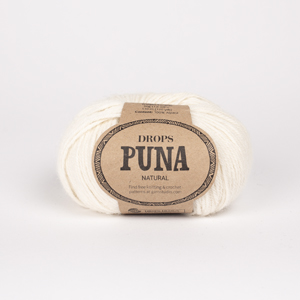



















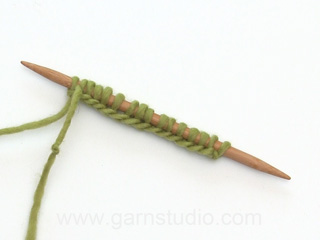






























Comments / Questions (12)
Hej. En liten fundering. Man ska göra mönster A13 över a9, a10, a11 som är 63 m bakstycke eftersom jag stickar på medium och på framstycket 32 m. Men mönster A13 är 6 m totalt och de är varken delbart med 63 m som är bakstyckets mönster eller 32 m som är framstyckernas mönster. Hur är det tänkt att man ska göra där? För att få det att gå ihop? Tack på förskott för svar 🙂 Mvh Anna
14.06.2019 - 13:18DROPS Design answered:
Hej Anna, jo men det ser samme mønster som du har strikket hele tiden, så det skal stemme over hinanden. De masker i hver side som ikke stemmer, skal bare strikkes i slätstickat. God fornøjelse!
09.07.2019 - 12:18Hej. Jag har kommit till att sticka mer rapporter på mönster A8-b och A12-b. Men på A 8 så på andra varvet med mönster så kommer det en trekant mellan a och b så hur ska jag kunna repetera bara b igen då? Samma gäller A12 så kommer det att man ska ta två ihop mellan a och b och samma där hur ska man kunna göra fler rapporter av endast b då? Som har 6 m. Hur löser jag det? Tacksam för svar 🙂 Mvh Anna
07.06.2019 - 08:24DROPS Design answered:
Hei Anna. Nå vet ikke jeg hvilke størrelse du strikker, men si at du strikker L/XL: fellingen på slutten av A.8b (= 2 masker vridd rett sammen) vil bli slått sammen med fellingen av den første masken, slik at du isteden strikker = " ta 1 maske løs av pinnen som om den skal strikkes rett, 2 masker rett sammen, løft den løse masken over maskene som ble strikket sammen " over de 2 siste + den førset masken i rapportene av A.8b. Dette kan du også se på rad 11: der er den sorte trekanten tegnet inn over de 2 siste maskene i A.8b + første maske av A.8c. Der A.8b gjentas strikkes denne fellingen i overgangen mellom rapportene. God fornøyelse
07.06.2019 - 09:16Come faccio per sapere cosa corrisponde la taglia l o xl in cm?
19.05.2019 - 18:28DROPS Design answered:
Buongiorno Tiziana. Alla fine delle spiegazioni, trova un grafico con le misure espresse in cm. Confrontando queste misure con quelle di un capo simile, riesce a capire a quale taglia lavorare. Buon lavoro!
19.05.2019 - 18:36Hello , Could You teach me to add 6 stitches in the A.8 , A.12 . A.10 and A.9 ( ( How to insert stitches in the patterns ? Increase many stitch a row ? Thank very much.
05.01.2019 - 21:51DROPS Design answered:
Dear Phan, I'm not sure to understand your question properly. The increases in this diagram are already shown in diagram (as in A.4-A.6 worked before). Happy knitting!
07.01.2019 - 11:00Hei, kjempefin jakke. Jeg har fått ros for den av tilfeldige forbispasserende! Det sier sitt! mvh Sonja
16.09.2018 - 13:40Hej igen Undskyld, jeg har fundet ud af det. Det var en tanketorsk vedr læsning af diagram så alt passer nu.
21.08.2018 - 08:06Hej Jeg kan simpelt hen ikke få målene til st passe efter endt udtagning. Strikker str L og ender ud med ca 30-31 cm i bærestykke. Strikkefastheden passer så hvad gør jeg forkert? Mvh Kate
18.08.2018 - 12:03DROPS Design answered:
Hej Kate, det lyder til at dine pinde fylder en anelse mere i højden, du kan prøve med ½ nummer mindre, eller så må du vælge en mindre størrelse, men følge længde målene som passer dig. God fornøjelse!
20.08.2018 - 09:38Bij het telpatroon van model DROPS design: Patroon pu-021Garengroep B\r\n\r\nstaat er 2x hetzelfde bij de uitleg van de kabel: \r\n= zet 3 steken op een kabelnaald en houd deze achter het werk, 3 recht, 3 recht van de kabelnaald \r\n= zet 3 steken op een kabelnaald en houd deze achter het werk, 3 recht, 3 recht van de kabelnaald.\r\nde 2e moet volgens mij \"VOOR\" de naald zijn.
22.07.2018 - 07:46In chart 4, row seven has 2 increases but the next row only shows 1 additional stitch. In Row 15 there are 4 increases but only 1 double decrease. I am not sure what to follow the pattern and ignore the stitch count or adjust the pattern to match the stitch count. Thanks for your help.
10.06.2018 - 00:48DROPS Design answered:
Dear Mrs Pinkerton, the first row in A.4 (on row 7) is for the increase to the raglan, the 2nd YO will replace the last st in A.4 (= the one that you will dec in A.5 slipping 1 st as if to K, K2 tog, psso). Happy knitting!
11.06.2018 - 09:17O início do esquema A1, começa com uma laçada (esquerda) ou com uma malha em meia (direito)? Eu estava a ler os esquemas da esquerda para a direita, mas ao ver a sequência do esquema A8, parece-me que a leitura será da direita para a esquerda. Fico na dúvida se os esquemas devem ser lidos da esquerda para a direita, ou da direita para a esquerda.\r\nObrigada pela vossa ajuda!\r\nTeresa
03.05.2018 - 11:09